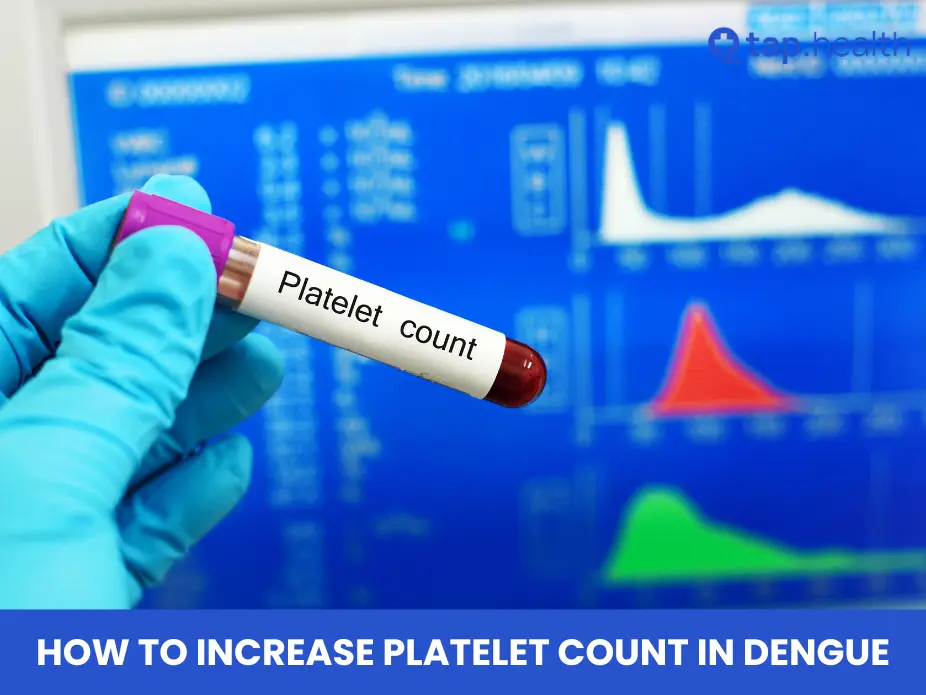Dengue fever is a viral illness transmitted by mosquitoes that can lead to a significant drop in platelet count. Platelets are crucial for blood clotting and maintaining overall health. A low platelet count, a condition known as thrombocytopenia, can cause severe complications. This blog provides a detailed guide on dengue, its impact on platelets, and practical steps to increase platelet count.
What is Dengue?
Dengue is a viral infection spread primarily by Aedes mosquitoes, particularly Aedes aegypti and Aedes albopictus. It is prevalent in tropical and subtropical regions and can lead to severe health issues if not managed properly.
Types of Dengue
Dengue Fever
Dengue Fever is the most common and mildest form of the disease. It presents with high fever, severe headaches, pain behind the eyes, muscle and joint pain, rash, nausea, and mild bleeding. Symptoms typically appear 4-10 days after a mosquito bite and can last for about a week.
Dengue Hemorrhagic Fever (DHF)
Dengue Hemorrhagic Fever is a more severe form of dengue that includes symptoms of dengue fever along with bleeding tendencies, plasma leakage, and low platelet count. It can lead to severe complications and requires prompt medical treatment.
Dengue Shock Syndrome (DSS)
Dengue Shock Syndrome is the most severe form and involves a sudden drop in blood pressure, leading to shock. It is a medical emergency that requires immediate and intensive treatment.
Symptoms of Dengue
- High Fever: Dengue often starts with a high fever that can reach up to 104°F (40°C).
- Severe Headache: Intense headaches, particularly behind the eyes.
- Muscle and Joint Pain: Severe pain in muscles and joints, often referred to as “breakbone fever.”
- Rash: A rash may appear a few days after the fever begins.
- Nausea and Vomiting: Patients may experience nausea and vomiting.
- Mild Bleeding: Such as nosebleeds, gum bleeding, or easy bruising.
Causes of Dengue
Dengue is caused by one of four related dengue virus serotypes (DEN-1, DEN-2, DEN-3, and DEN-4). The virus is transmitted through the bite of an infected mosquito. Infection with one serotype provides lifelong immunity to that specific serotype but only partial immunity to the others, making repeated infections possible.
The Role of Platelets in the Body
Platelets, also known as thrombocytes, are small, disc-shaped cell fragments in the blood. They play a crucial role in blood clotting and wound healing.
Key Functions of Platelets
- Clot Formation: Platelets aggregate at the site of a blood vessel injury to form a plug. This is the first step in stopping bleeding.
- Chemical Release: They release chemicals like ADP and thromboxane A2, which enhance the clotting process.
- Interaction with Clotting Factors: Platelets provide a surface for clotting factors to assemble and form a stable blood clot. This involves converting fibrinogen into fibrin, which strengthens the platelet plug.
- Wound Healing: Platelets release growth factors like Platelet-Derived Growth Factor (PDGF) that aid in tissue repair and regeneration.
Why Do Platelets Drop in Dengue?
Platelet counts can drop significantly in dengue due to several reasons:
- Viral Infiltration: The dengue virus can invade the bone marrow, where platelets are produced, disrupting normal production.
- Increased Platelet Destruction: The immune system may mistakenly target and destroy platelets during the body’s response to the virus.
- Increased Vascular Permeability: Dengue can cause blood vessels to become more permeable, leading to leakage of plasma and a drop in platelet count.
What are the Symptoms Associated With Low Platelets in Dengue?
When platelet counts are low, patients may experience several symptoms indicating potential complications:
Easy Bruising or Bleeding
- Petechiae: Small, pinpoint red or purple spots on the skin that appear without an obvious cause.
- Ecchymosis: Larger bruises or reddish-brown patches caused by minor trauma.
- Nosebleeds and Gum Bleeding: Increased bleeding from the nose or gums, often occurring spontaneously.
Severe Abdominal Pain
- Abdominal pain can indicate internal bleeding. This requires immediate medical attention.
Vomiting Blood
- Vomiting blood is a serious sign of possible internal bleeding and needs urgent care.
Black Stools or Blood in the Urine
- Black or tarry stools and blood in the urine are signs of internal bleeding that need prompt medical evaluation.
How to Increase Platelet Count in Dengue?
Raising platelet counts involves both dietary measures and medical interventions. Here’s how you can manage and support your recovery:
Dietary Strategies
- Essential Nutrients: Ensure a balanced diet rich in vitamins and minerals that support platelet production:
- Vitamin C: Found in citrus fruits like oranges and grapefruits, as well as bell peppers and strawberries.
- Vitamin B12: Present in lean meats, fish, eggs, and dairy products.
- Folate: Found in leafy greens like spinach and kale, and legumes like lentils and beans.
- Vitamin K: Available in leafy greens, broccoli, and asparagus.
- Iron: Sources include lean meats, beans, lentils, and fortified cereals.
- Platelet-Friendly Foods: Some foods may help boost platelet levels:
- Papaya: Consuming ripe papaya may support platelet health. Avoid papaya leaves as they contain toxins.
- Pomegranate: Rich in antioxidants, it may help in maintaining platelet health.
- Dates: A good source of iron and other essential nutrients.
- Hydration: Drink plenty of fluids such as water, coconut water, and clear broths. Avoid sugary drinks and excessive caffeine to stay hydrated and support overall health.
Medical Strategies
- Medications: Consult a healthcare provider for medications that may stimulate platelet production or manage symptoms.
- Platelet Transfusions: In severe cases with critically low platelet counts or significant bleeding, platelet transfusions may be necessary. This procedure should be done under medical supervision.
Treatment for Low Platelets in Dengue
Managing low platelet counts involves both supportive and medical treatments:
- Monitoring: Regular monitoring of platelet levels to track progress and make necessary adjustments to treatment.
- Fluid Management: Ensuring proper hydration and monitoring fluid balance to avoid complications.
- Medications: Using prescribed medications to manage symptoms and support recovery.
- Platelet Transfusions: Administered if platelet counts fall below critical levels or if there are signs of bleeding complications.
When to See a Doctor
Seek medical attention if you experience:
- Severe Symptoms: Persistent bleeding, severe abdominal pain, or high fever.
- Rapid Decline: Significant or sudden drop in platelet count.
- Complications: Signs of dengue shock syndrome, hemorrhagic fever, or other serious complications.
FAQ on How to Increase Platelet Count in Dengue
1. What is the Minimum Platelet Count Considered Safe in Dengue?
A platelet count above 100,000 per cubic millimeter is generally considered safe. Counts below this may require closer monitoring and intervention.
2. How Quickly Can Platelet Counts Drop in Dengue?
Platelet counts can drop rapidly, often within a few days of symptom onset.
3. Can Platelet Counts Recover on Their Own?
Yes, with proper medical care and supportive treatments, platelet counts can recover as the body fights off the dengue virus.
4. Are There Natural Ways to Boost Platelet Count?
Diet and hydration can support overall health, but medical intervention may be necessary for critically low counts.
5. When Should Platelet Transfusions Be Considered?
Transfusions are typically considered when platelet counts drop below 20,000 per cubic millimeter or if there are significant bleeding symptoms.
References
- “Dengue Fever – World Health Organization.” World Health Organization, link.
- “Dengue Hemorrhagic Fever – CDC.” Centers for Disease Control and Prevention.
- “Platelets and Blood Clotting – National Heart, Lung, and Blood Institute.” NIH, link.
- “Dengue Fever: Symptoms, Diagnosis, and Treatment – National Center for Biotechnology Information.” PubMed Central, link.



